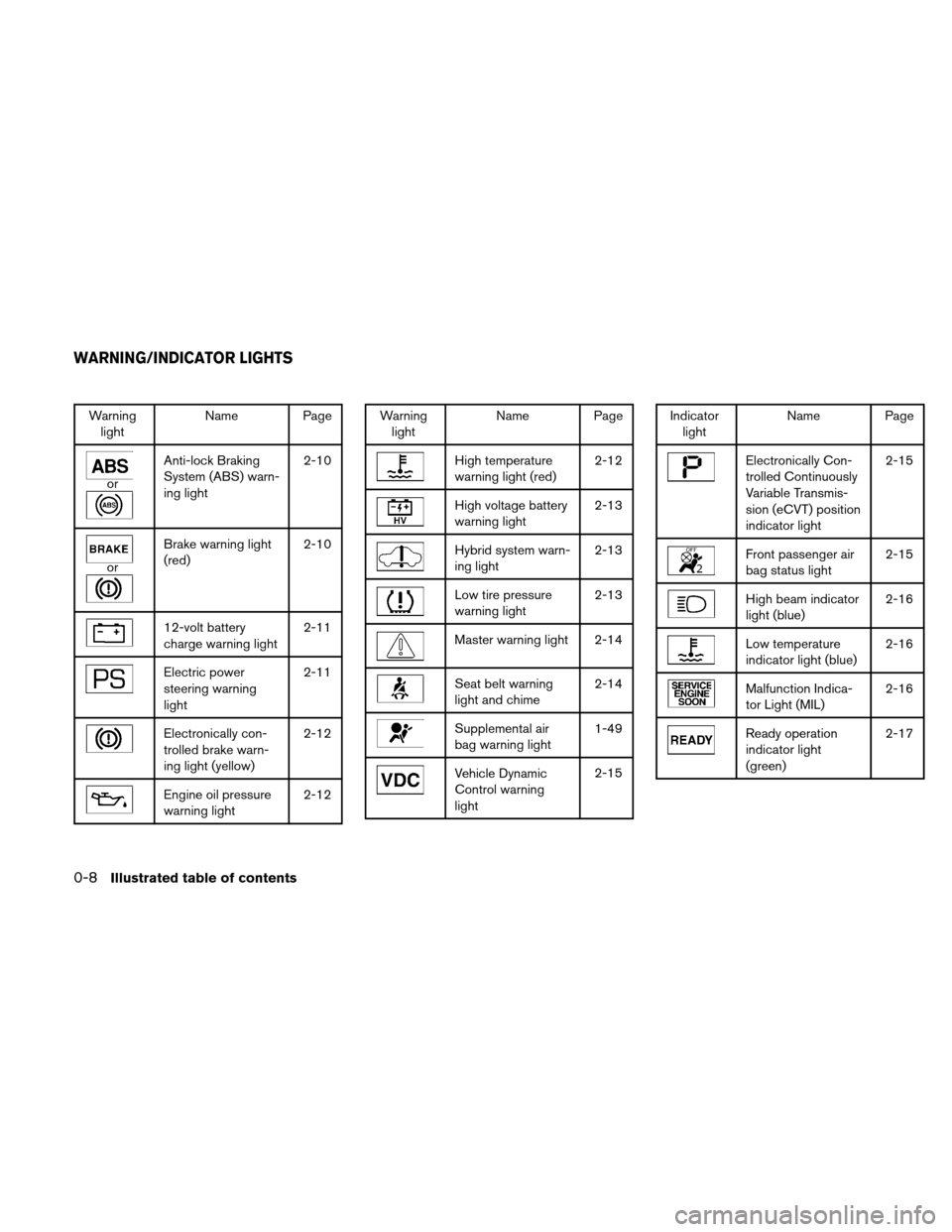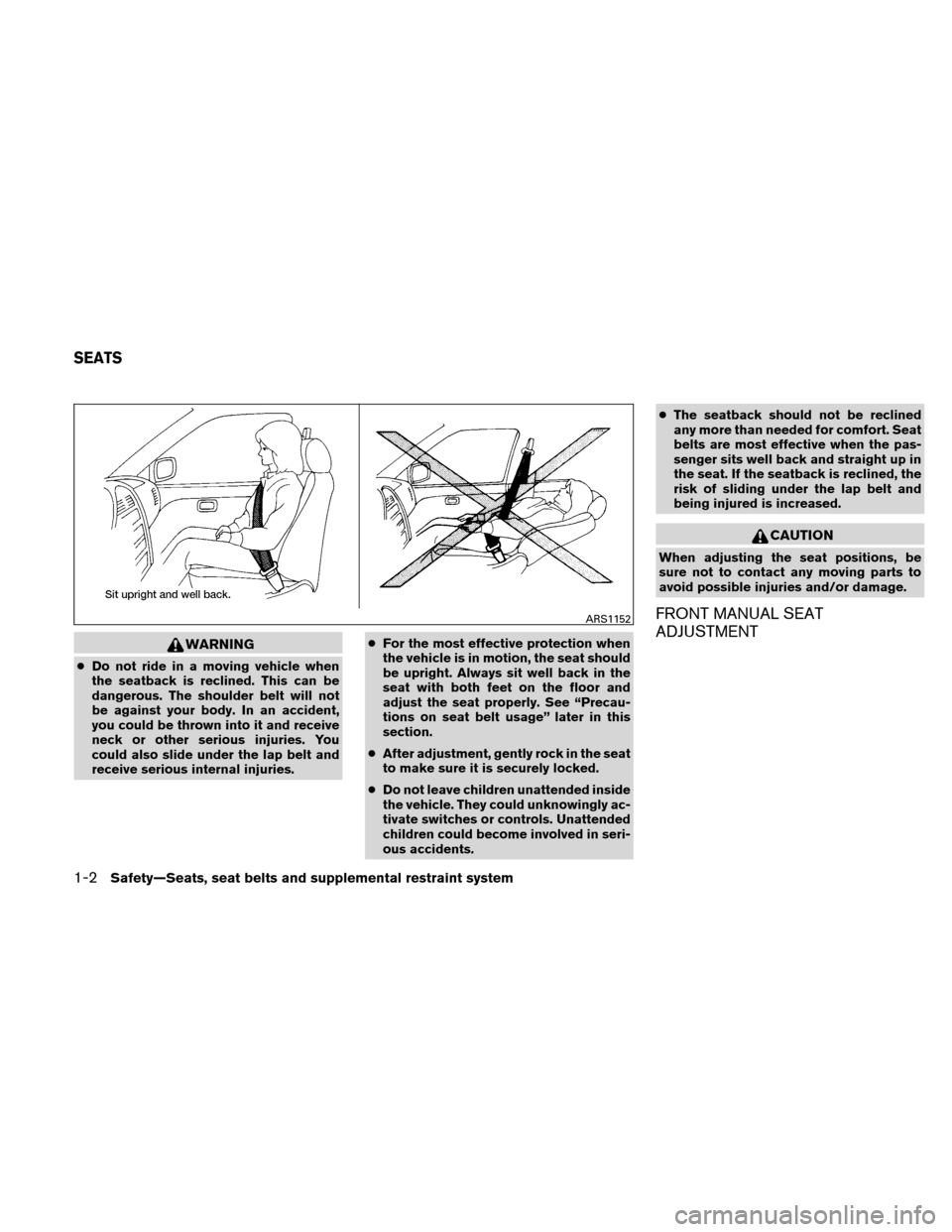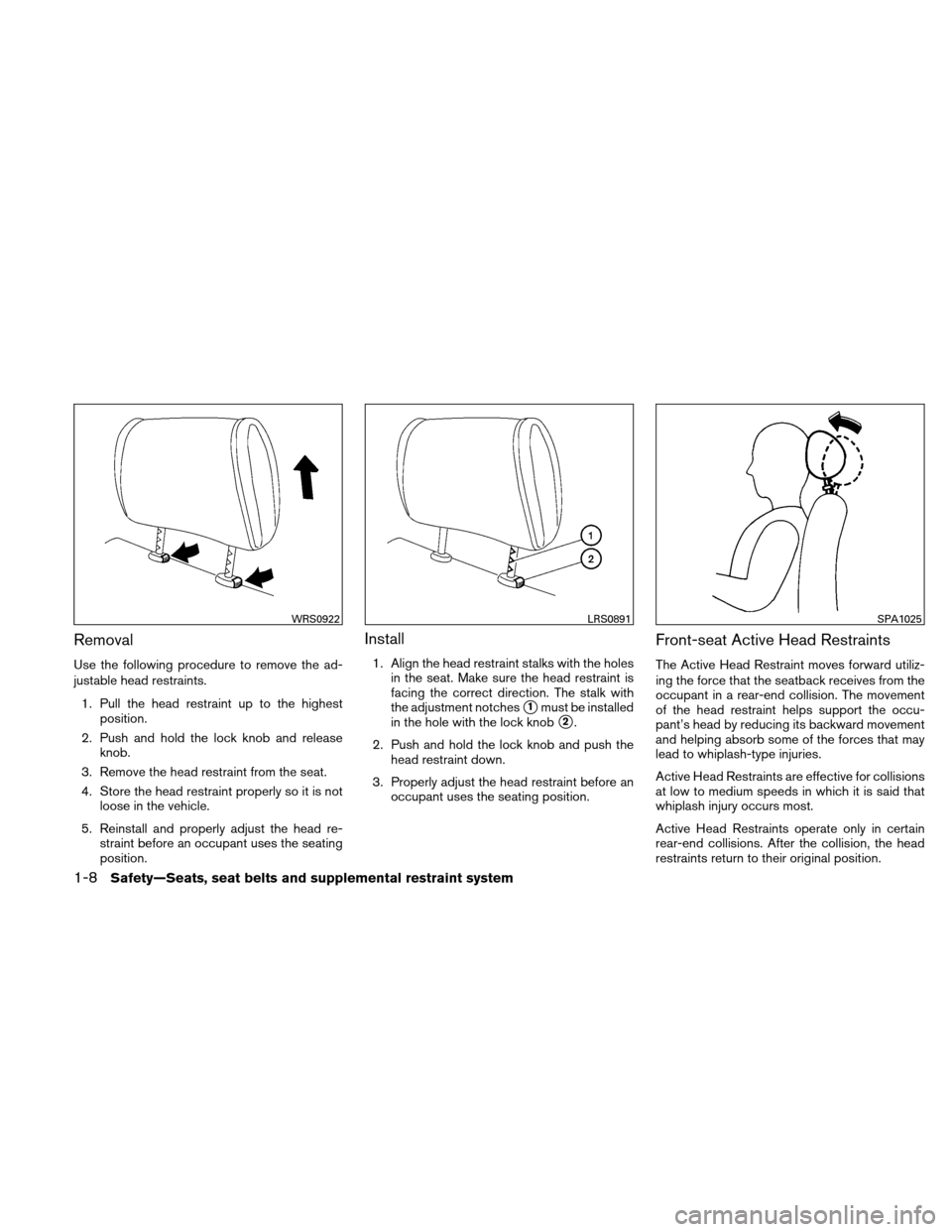Page 22 of 422
1. Power windows (P. 2-40)
2. Windshield (P. 8-17)
3. Windshield wiper and washer switch(P. 2-28)
4. Engine hood (P. 3-18)
5. Tie down (P. 6-13)
6. Headlight and turn signal switch
(P. 2-29)
7. Replacing bulbs (P. 8-24)
8. Tire pressure (P. 8-29)
9. Flat tire (P. 6-2)
10. Tire chains (P. 8-37)
11. Mirrors (P. 3-24)
12. Door locks, NISSAN Intelligent Key ™ ,
keys (P. 3-4, 3-2, 3-2)
See the page number indicated in paren-
theses for operating details.
WII0179
EXTERIOR FRONT
Illustrated table of contents0-3
Page 23 of 422
1. Antenna (P. 4-85)
2. Rear window and outside mirror(if so equipped) defroster switch
(P. 2-29)
3. Interior trunk lid release, secondary
trunk lid release (P. 3-20, P. 3-19)
4. Trunk lid (P. 3-18)
5. Vehicle loading (P.9-12)
6. Exterior trunk lid release (P.3-13)
7. Replacing bulbs (P. 8-24)
8. Fuel-filler cap, fuel recommendation
(P. 3-21, P. 9-28)
9. Fuel-filler door (P. 3-21)
10. Child safety rear door lock (P. 3-6)
WII0104
EXTERIOR REAR
0-4Illustrated table of contents
Page 27 of 422

Warninglight Name Page
or
Anti-lock Braking
System (ABS) warn-
ing light 2-10
or
Brake warning light
(red)
2-10
12-volt battery
charge warning light2-11
Electric power
steering warning
light2-11
Electronically con-
trolled brake warn-
ing light (yellow)2-12
Engine oil pressure
warning light
2-12
Warning
light Name Page
High temperature
warning light (red) 2-12
High voltage battery
warning light2-13
Hybrid system warn-
ing light2-13
Low tire pressure
warning light2-13
Master warning light 2-14
Seat belt warning
light and chime2-14
Supplemental air
bag warning light1-49
Vehicle Dynamic
Control warning
light2-15
Indicator
light Name Page
Electronically Con-
trolled Continuously
Variable Transmis-
sion (eCVT) position
indicator light 2-15
Front passenger air
bag status light
2-15
High beam indicator
light (blue)2-16
Low temperature
indicator light (blue)2-16
Malfunction Indica-
tor Light (MIL)2-16
Ready operation
indicator light
(green)2-17
WARNING/INDICATOR LIGHTS
0-8Illustrated table of contents
Page 31 of 422

WARNING
●Do not ride in a moving vehicle when
the seatback is reclined. This can be
dangerous. The shoulder belt will not
be against your body. In an accident,
you could be thrown into it and receive
neck or other serious injuries. You
could also slide under the lap belt and
receive serious internal injuries. ●
For the most effective protection when
the vehicle is in motion, the seat should
be upright. Always sit well back in the
seat with both feet on the floor and
adjust the seat properly. See “Precau-
tions on seat belt usage” later in this
section.
● After adjustment, gently rock in the seat
to make sure it is securely locked.
● Do not leave children unattended inside
the vehicle. They could unknowingly ac-
tivate switches or controls. Unattended
children could become involved in seri-
ous accidents. ●
The seatback should not be reclined
any more than needed for comfort. Seat
belts are most effective when the pas-
senger sits well back and straight up in
the seat. If the seatback is reclined, the
risk of sliding under the lap belt and
being injured is increased.
CAUTION
When adjusting the seat positions, be
sure not to contact any moving parts to
avoid possible injuries and/or damage.
FRONT MANUAL SEAT
ADJUSTMENTARS1152
SEATS
1-2Safety—Seats, seat belts and supplemental restraint system
Page 32 of 422
Forward and backward
Pull the center of the bar up and hold it while you
slide the seat forward or backward to the desired
position. Release the bar to lock the seat in
position.
Reclining
To recline the seatback, pull the lever up and lean
back. To bring the seatback forward, pull the lever
up and lean your body forward. Release the lever
to lock the seatback in position.
The reclining feature allows adjustment of the
seatback for occupants of different sizes for
added comfort and to help obtain proper seat
belt fit. See “Precautions on seat belt usage” later
in this section. Also, the seatback can be reclined
to allow occupants to rest when the vehicle is
stopped and the transmission is in the P (Park)
position.
Seat lifter (driver’s side)
Pull up or push down the adjusting lever to adjust
the seat height until the desired position is
achieved.
WRS0738WRS0739WRS0740
Safety—Seats, seat belts and supplemental restraint system1-3
Page 35 of 422

HEAD RESTRAINTS
WARNING
Head restraints supplement the other ve-
hicle safety systems. They may provide
additional protection against injury in cer-
tain rear end collisions. Adjust the head
restraints properly, as specified in this
section. Check the adjustment after
someone else uses the seat. Do not attach
anything to the head restraint stalks or
remove the head restraint. Do not use the
seat if the head restraint has been re-
moved. If the head restraint was removed,
reinstall and properly adjust the head re-
straint before an occupant uses the seat-
ing position. Failure to follow these in-
structions can reduce the effectiveness of
the head restraints. This may increase the
risk of serious injury or death in a
collision.The illustration shows the seating positions
equipped with head restraints. All of the head
restraints are adjustable.
�
Indicates the seating position is equipped with
a head restraint.
Components
1. Head restraint
2. Adjustment notches
3. Lock knob
4. Stalks
5. Release knob
LRS0893WRS0921
1-6Safety—Seats, seat belts and supplemental restraint system
Page 36 of 422
Adjustment
Adjust the head restraint so the center is level
with the center of the seat occupant’s ears.To raise the head restraint, pull it up.
To lower, push and hold the lock knob and push
the head restraint down.
WRS0134LRS0888LRS0889
Safety—Seats, seat belts and supplemental restraint system1-7
Page 37 of 422

Removal
Use the following procedure to remove the ad-
justable head restraints.1. Pull the head restraint up to the highest position.
2. Push and hold the lock knob and release knob.
3. Remove the head restraint from the seat.
4. Store the head restraint properly so it is not loose in the vehicle.
5. Reinstall and properly adjust the head re- straint before an occupant uses the seating
position.
Install
1. Align the head restraint stalks with the holesin the seat. Make sure the head restraint is
facing the correct direction. The stalk with
the adjustment notches
�1must be installed
in the hole with the lock knob
�2.
2. Push and hold the lock knob and push the head restraint down.
3. Properly adjust the head restraint before an occupant uses the seating position.
Front-seat Active Head Restraints
The Active Head Restraint moves forward utiliz-
ing the force that the seatback receives from the
occupant in a rear-end collision. The movement
of the head restraint helps support the occu-
pant’s head by reducing its backward movement
and helping absorb some of the forces that may
lead to whiplash-type injuries.
Active Head Restraints are effective for collisions
at low to medium speeds in which it is said that
whiplash injury occurs most.
Active Head Restraints operate only in certain
rear-end collisions. After the collision, the head
restraints return to their original position.
WRS0922LRS0891SPA1025
1-8Safety—Seats, seat belts and supplemental restraint system